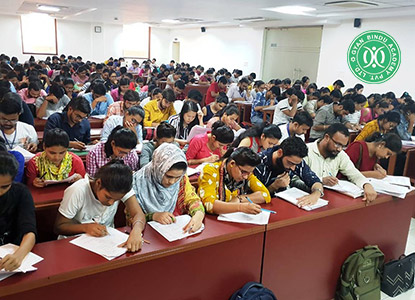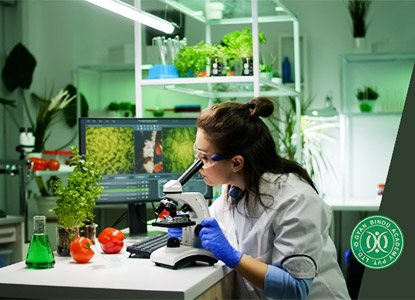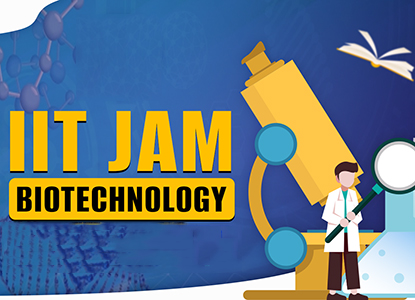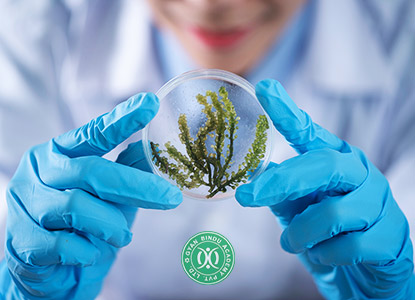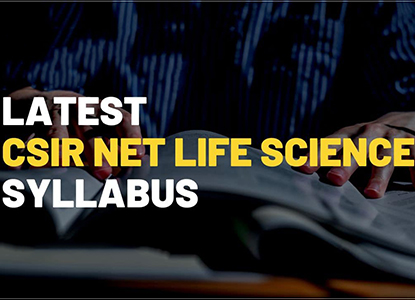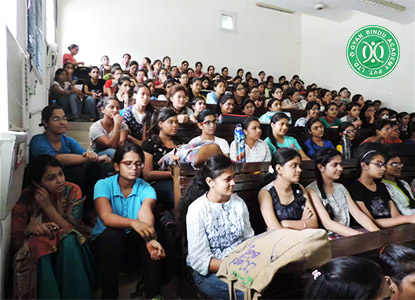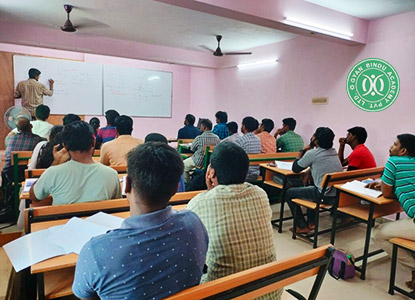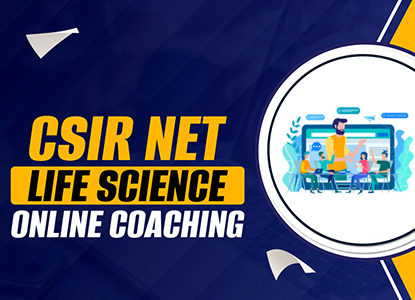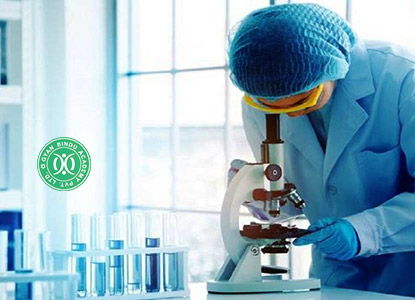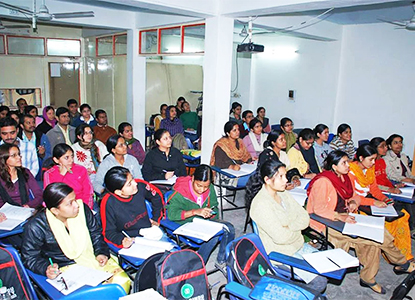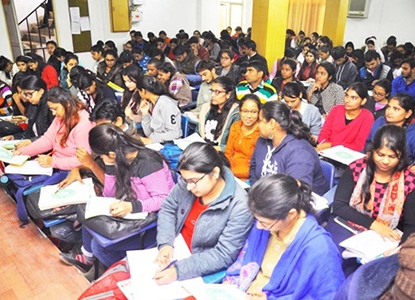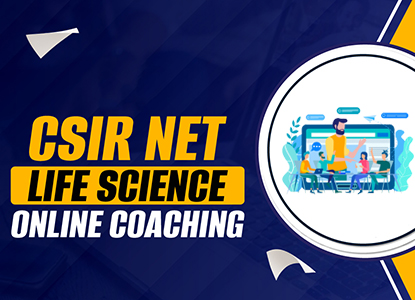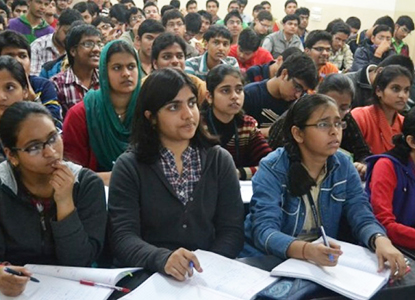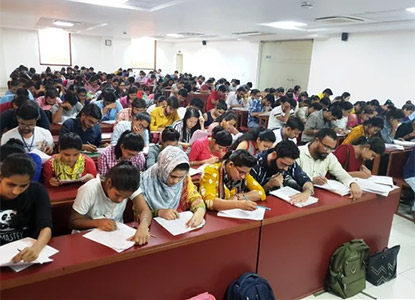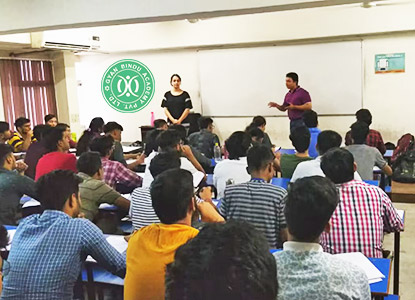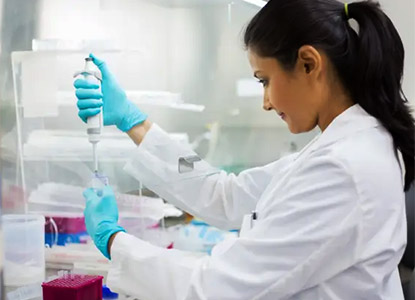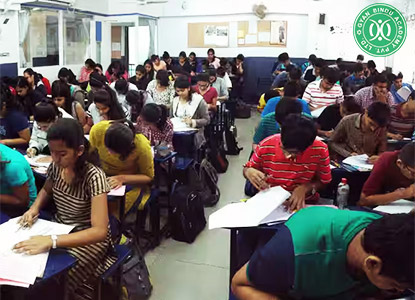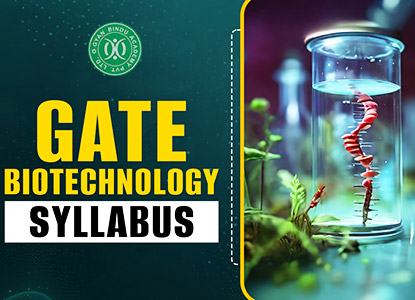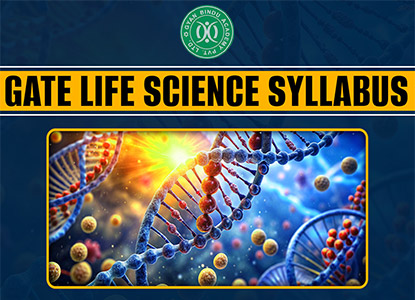
XL (Life Sciences under XL)
A candidate appearing in the XL paper has to answer the following section
- Section H - Chemistry (compulsory)
- GA - General Aptitude (compulsory)
- Any two of XL sections I to M
The choice of two sections from I to M can be made during the examination after viewing the questions. Only two optional sections can be answered by the candidate. A candidate wishing to change midway through the examination to another optional section must first choose to deselect one of the previously chosen optional sections (I to M).
XL- SECTION H. Chemistry (Compulsory)
Atomic structure and periodicity: Plancks quantum theory, wave-particle duality, uncertainty principle, quantum mechanical model of hydrogen atom; electronic configuration of atoms; periodic table and periodic properties; ionization energy, electron affinity, electronegativity, atomic size.
Structure and bonding: Ionic and covalent bonding, M.O. and V.B. approach for diatomic molecules, VSEPR theory, and shape of molecules, hybridization, resonance, dipole moment, structure parameters such as bond length, bond angle and bond energy, hydrogen bonding, van der Waals interactions. Ionic solids, ionic radii, lattice energy (Born-Haber Cycle).
s.p. and d Block Elements: Oxides, halides, and hydrides of alkali and alkaline earth metals, B, Al, Si, N, P, and S, general characteristics of 3d elements, coordination complexes: valence bond and crystal field theory, color, geometry, and magnetic properties.
Chemical Equilibria: Colligative properties of solutions, ionic equilibria in solution, solubility product, common ion effect, hydrolysis of salts, pH, buffer and their applications in chemical analysis, equilibrium constants (Kc, Kp, and Kx) for homogeneous reactions,
Electrochemistry: Conductance, Kohlrausch law, Half Cell potentials, emf, Nernst equation, galvanic cells, thermodynamic aspects, and their applications.
Reaction Kinetics: Rate constant, order of reaction, molecularity, activation energy, zero, first and second-order kinetics, catalysis, and elementary enzyme reactions.
Thermodynamics: First law, reversible and irreversible processes, internal energy, enthalpy, Kirchoffs equation, the heat of reaction, Hess law, the heat of formation, Second law, entropy, free energy, and work function. Gibbs-Helmholtz equation, Clausius-Clapeyron equation, free energy change and equilibrium constant, Croutons rule, Third law of thermodynamics.
Basis of Organic Reactions Mechanism: Elementary treatment of SN1, SN2, E1, and E2 reactions, Hoffmann and Saytzeff rules, Addition reactions, Markonikoff rule, and Kharash effect, Diels-Alder reaction, aromatic electrophilic substitution, orientation effect as exemplified by various functional groups. Identification of functional groups by chemical tests
Structure-Reactivity Correlations: Acids and bases, electronic and steric effects, optical and geometrical isomerism, tautomerism, conformers, the concept of aromaticity
Choose Any two of XL sections I to M syllabus as given
XL- SECTION I. BIOCHEMISTRY
Organization of life. Importance of water. Cell structure and organelles. Structure and function of biomolecules: Amino acids, Carbohydrates, Lipids, Proteins, and Nucleic acids. Biochemical separation techniques and characterization: ion exchange, size exclusion, and affinity chromatography, electrophoresis, UV-visible, fluorescence, and Mass spectrometry. Protein structure, folding, and function: Myoglobin, Hemoglobin, Lysozyme, Ribonuclease A, Carboxypeptidase, and Chymotrypsin. Enzyme kinetics including its regulation and inhibition, Vitamins, and Coenzymes.
Metabolism and bioenergetics. Generation and utilization of ATP. Metabolic pathways and their regulation: glycolysis, TCA cycle, pentose phosphate pathway, oxidative phosphorylation, gluconeogenesis, glycogen, and fatty acid metabolism. Metabolism of Nitrogen-containing compounds: nitrogen fixation, amino acids, and nucleotides. Photosynthesis: the Calvin cycle.
Biological membranes. Transport across membranes. Signal transduction; hormones and neurotransmitters.
DNA replication, transcription, and translation. Biochemical regulation of gene expression. Recombinant DNA technology and applications: PCR, site-directed mutagenesis, and DNA microarray.
Immune system. Active and passive immunity. Complement system. Antibody structure, function, and diversity. Cells of the immune system: T, B, and macrophages. T and B cell activation. Major histocompatibility complex. T cell receptor. Immunological techniques: Immunodiffusion, immunoelectrophoresis, RIA, and ELISA.
SECTION J. BIOTECHNOLOGY
Advanced techniques in gene expression and analysis: PCR and RT-PCR, microarray technology, DNA fingerprinting and recombinant DNA technology; prokaryotic and eukaryotic expression systems; Vectors: plasmids, phages, cosmids, and BAC.
The architecture of plant genome; plant tissue culture techniques; methods of gene transfer into plant cells and development of transgenic plants; manipulation of phenotypic traits in plants; plant cell fermentation and production of secondary metabolites using suspension/immobilized cell culture; expression of animal protein in plants; genetically modified crops.
Animal cell metabolism and regulation; cell cycle; primary cell culture; nutritional requirements for animal cell culture; techniques for mass culture of animal cell lines; application of animal cell culture for production of vaccines, growth hormones; interferons, cytokines, and therapeutic proteins; hybridoma technology and gene knockout; stem cells and its application in organ synthesis; gene therapy; transgenic animals and molecular pharming.
Industrial bioprocesses: microbial production of organic acids, amino acids, proteins, polysaccharides, lipids, polyhydroxyalkanoates, antibiotics, and pharmaceuticals; methods and applications of immobilization of cells and enzymes; kinetics of soluble and immobilized enzymes; biosensors; biofuels; biopesticides; environmental bioremediation.
Microbial growth kinetics; batch, fed-batch, and continuous culture of microbial cells; media for industrial fermentations; sterilization of air and media, design and operation of stirred tank, airlift, plug flow, packed bed, fluidized bed, membrane, and hollow fiber reactors; aeration and agitation in aerobic fermentations; bioprocess calculations based on material and energy balance; Downstream processing in industrial biotechnology: filtration, precipitation, centrifugation, cell disintegration, solvent extraction, and chromatographic separations, membrane filtration, aqueous two-phase separation.
Bioinformatics; genomics; proteomics and computational biology.
XL- SECTION SECTION K. BOTANY
Plant Systematics: Systems of classification (non-phylogenetic vs. phylogenetic - outline), plant groups, molecular systematics.
Plant Anatomy: Plant cell structure, organization, organelles, cytoskeleton, cell wall and membranes; anatomy of root, stem, and leaves, meristems, vascular system, their ontogeny, structure and functions, secondary growth in plants, and stellar organization.
Morphogenesis & Development: Cell cycle, cell division, the life cycle of an angiosperm, pollination, fertilization, embryogenesis, seed formation, seed storage proteins, seed dormancy, and germination.
Concept of cellular totipotency, clonal propagation; organogenesis and somatic embryogenesis, artificial seed, somaclonal variation, secondary metabolism in plant cell culture, embryo culture, in vitro fertilization.
Physiology and Biochemistry: Plant water relations, transport of minerals and solutes, stress physiology, stomatal physiology, signal transduction, N2 metabolism, photosynthesis, photorespiration; respiration, Flowering: photoperiodism and vernalization, biochemical mechanisms involved in flowering; molecular mechanism of senescence and aging, biosynthesis, mechanism of action and physiological effects of plant growth regulators, structure and function of biomolecules, (proteins, carbohydrates, lipids, nucleic acid), enzyme kinetics.
Genetics: Principles of Mendelian inheritance, linkage, recombination, genetic mapping; extrachromosomal inheritance; prokaryotic and eukaryotic genome organization, regulation of gene expression, gene mutation, and repair, chromosomal aberrations (numerical and structural), transposons.
Plant Breeding and Genetic Modification: Principles, methods as selection, hybridization, heterosis; male sterility, genetic maps and molecular markers, sporophytic and gametophytic self-incompatibility, haploidy, triploidy, somatic cell hybridization, marker-assisted selection, gene transfer methods viz. direct and vector-mediated, plastid transformation, transgenic plants and their application in agriculture, molecular pharming, plantibodies.
Economic Botany: A general account of economically and medicinally important plants- cereals, pulses, plants yielding fibers, timber, sugar, beverages, oils, rubber, pigments, dyes, gums, drugs, and narcotics. Economic importance of algae, fungi, lichen, and bacteria.
Plant Pathology: Nature and classification of plant diseases, diseases of important crops caused by fungi, bacteria, and viruses, and their control measures, the mechanism(s) of pathogenesis and resistance, molecular detection of pathogens; plant-microbe beneficial interactions.
Ecology and Environment: Ecosystems as types, dynamics, degradation, ecological succession; food chains and energy flow; vegetation types of the world, pollution and global warming, speciation, and extinction, conservation strategies, cryopreservation, phytoremediation.
XL- SECTION L. MICROBIOLOGY
Historical Perspective: Discovery of microbial world Landmark discoveries relevant to the field of microbiology; Controversy over a spontaneous generation; Role of microorganisms in transformation of organic matter and in the causation of diseases.
Methods in Microbiology: Pure culture techniques; Theory and practice of sterilization; Principles of microbial nutrition; Enrichment culture techniques for isolation of microorganisms; Light-phase contrast- and electron microscopy.
Microbial Taxonomy and Diversity: Bacteria, Archea, and their broad classification; Eukaryotic microbes: Yeasts, molds, and protozoa; Viruses and their classification; Molecular approaches to microbial taxonomy.
Prokaryotic and Eukaryotic Cells: Structure and Function: Prokaryotic Cells: cell walls, cell membranes, mechanisms of solute transport across membranes, Flagella and Pili, Capsules, Cell inclusions like endospores and gas vesicles; Eukaryotic cell organelles: Endoplasmic reticulum, Golgi apparatus, mitochondria, and chloroplasts.
Microbial Growth: Definition of growth; Growth curve; Mathematical expression of exponential growth phase; Measurement of growth and growth yields; Synchronous growth; Continuous culture; Effect of environmental factors on growth.
Control of Micro-organisms: Effect of physical and chemical agents; Evaluation of the effectiveness of antimicrobial agents.
Microbial Metabolism: Energetics: redox reactions and electron carriers; An overview of metabolism; Glycolysis; Pentose-phosphate pathway; Entner-Doudoroff pathway; Glyoxalate pathway; The citric acid cycle; Fermentation; Aerobic and anaerobic respiration; Chemolithotrophy; Photosynthesis; Calvin cycle; Biosynthetic pathway for fatty acids synthesis; Common regulatory mechanisms in the synthesis of amino acids; Regulation of major metabolic pathways.
Microbial Diseases and Host-Pathogen Interaction: Normal microbiota; Classification of infectious diseases; Reservoirs of infection; Nosocomial infection; Emerging infectious diseases; Mechanism of microbial pathogenicity; Nonspecific defense of host; Antigens and antibodies; Humoral and cell-mediated immunity; Vaccines; Immune deficiency; Human diseases caused by viruses, bacteria, and pathogenic fungi.
Chemotherapy/Antibiotics: General characteristics of antimicrobial drugs; Antibiotics: Classification, mode of action and resistance; Antifungal and antiviral drugs.
Microbial Genetics: Types of mutation; UV and chemical mutagens; Selection of mutants; Ames test for mutagenesis; Bacterial genetic system: transformation, conjugation, transduction, recombination, plasmids, transposons; DNA repair; regulation of gene expression: repression and induction; Operon model; Bacterial genome with special reference to E.coli; Phage and its life cycle; RNA phages; RNA viruses; Retroviruses; the Basic concept of microbial genomics.
Microbial Ecology: Microbial interactions; Carbon, sulfur, and nitrogen cycles; Soil microorganisms associated with vascular plants.
XL- SECTION M. ZOOLOGY
Animal world: Animal diversity, distribution, systematics and classification of animals, phylogenetic relationships.
Evolution: Origin and history of life on earth, theories of evolution, natural selection, adaptation, speciation.
Genetics: Principles of inheritance, the molecular basis of heredity, mutations, cytoplasmic inheritance, linkage, and mapping of genes.
Biochemistry and Molecular Biology: Nucleic acids, proteins, lipids, and carbohydrates; replication, transcription, and translation; regulation of gene expression, organization of the genome, Krebs cycle, glycolysis, enzyme catalysis, hormones, and their actions, vitamins.
Cell Biology: Structure of cell, cellular organelles and their structure and function, cell cycle, cell division, chromosomes, and chromatin structure. Eukaryotic gene organization and expression (Basic principles of signal transduction).
Animal Anatomy and Physiology: Comparative physiology, the respiratory system, circulatory system, digestive system, the nervous system, the excretory system, the endocrine system, the reproductive system, the skeletal system, osmoregulation.
Parasitology and Immunology: Nature of parasite, host-parasite relation, protozoan and helminthic parasites, the immune response, cellular and humoral immune response, evolution of the immune system.
Development Biology: Embryonic development, cellular differentiation, organogenesis, metamorphosis, the genetic basis of development, stem cells.
Ecology: The ecosystem, habitats, the food chain, population dynamics, species diversity, zoogeography, biogeochemical cycles, conservation biology.
Animal Behaviour: Types of behaviors, courtship, mating and territoriality, instinct, learning and memory, social behavior across the animal taxa, communication, pheromones, evolution of animal behavior.






